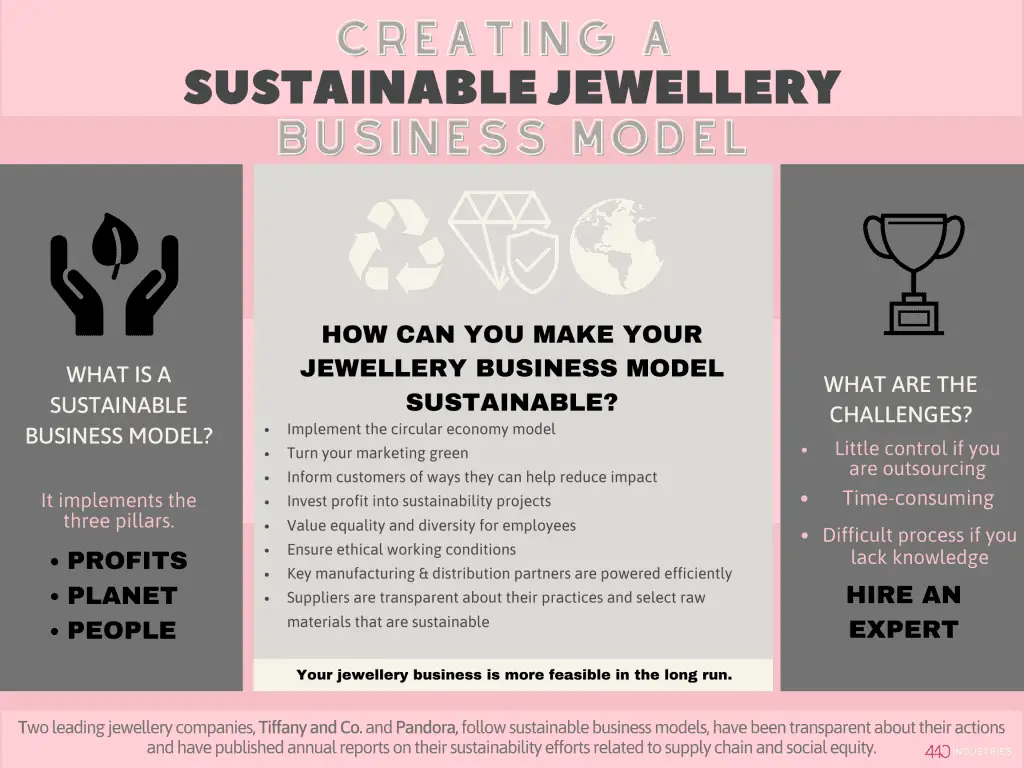Introduction
If you are wondering how a sustainable business model works and are looking for inspiration on making your jewellery business model sustainable, you have arrived at the right place. When it comes to business models, there are so many different types. With sustainability becoming a rising topic among businesses, you may want to consider including this in the model. When implementing this, your business will focus on reducing environmental impacts and improving social capital. We are going to discuss how to make a sustainable business model, successful jewellery companies with these types of models, and challenges associated with following this business model. Continue reading to learn more.
In this post we’re going to explore the following topics:
- What is a sustainable business model?
- Making your jewellery business model sustainable
- Jewellery companies that have a sustainable business model
- Challenges companies face with sustainable business models
- Conclusions
1.What is a sustainable business model?
A traditional business model refers to a company’s detailed plan on how they are delivering products to customers to make a profit. For a sustainable business model, it does this same thing while also focusing on eliminating the depletion of natural, economic and social capital. Sustainability is becoming increasingly important across all industries and is a long-term commitment. Utilizing sustainability can give your jewellery business a competitive advantage.
When it comes to sustainability, there is the triple-bottom-line-approach, also known as the three pillars – profits, planet, and people. The environmental pillar often gets the most attention, but the other two are equally as important. In order to make your jewellery business more sustainable, you must implement these three pillars into the segments of your business canvas model. If you’re interested in learning more about the BMC here’s an article for you!
Corporate social responsibility (CSR) has become an important issue as companies strive to balance their need for profitability and contributing to the well-being of society they continually depend on. There are a wide range of CSR strategies developed within the company that are related to philanthropy, ensuring diversity in the workplace, improving operational effectiveness by focusing on social and environmental initiatives across the value chain, and eventually transforming the business model. This self-regulating business model allows companies to be socially accountable and be conscious of their impact. CSR is at the core of operations and guides future progress.
We are going to discuss how to implement these practices for a sustainable business model in the next section.
2.Making your jewellery business model sustainable.
Green business models allow for the opportunity of recycling and reusing materials repeatedly. The other assets of profits and people come together to shape the business model for sustainable practices too.
There is a special type of model that allows for sustainability. In contract to the ‘take, make and waste’ approach or linear economy model that mines raw materials and processes this into a product with the product eventually discarded, the circular economy model changes the way in which production impacts the environment. The perspectives of these two concepts are complete opposites. The linear economy model is short term, from sales to purchase. The circular economy model is more long term, and is centred around three principles that reduce negative impacts:
- Design out waste and pollution. The negative impacts from the use of resources is minimized, including toxic chemicals, greenhouse gases, and any other air, water and land pollution.
- Keep products and materials in use. The reuse of products is maximized so materials keep circulating in the system.
- Regenerate natural systems. Renewable resources are used as opposed to nonrenewable resources, and raw materials are recycled too.
With these steps, some materials can safely re-enter the natural world, while some must go through the cycle because they cannot re-enter the environment. Included in this second category are plastics and metals. Using this circular economy method will allow metal from jewellery to cycle through to be reused repeatedly.
Here are additional ways for sustainability in your business model that are separated into the three pillars.
Planet
- Your key manufacturing partners should be powered efficiently. This includes any in-house production and/or any outsourcing during the production process. Invest in using energy-efficient practices, like renewable energy or LED lighting for power, reducing waste and emissions, and reusing materials.
- Making custom jewellery pieces a part of your business model can allow for sustainability. Compared to mass-produced pieces, custom pieces are usually one-of-a-kind so you will be able to manage the environmental impact more easily.
- Look into your distribution channels. With an online jewellery business, your primary way to distribute products is through the mail. One of the simplest tasks is minimizing packaging materials and offering lightweight, biodegradable or compostable packaging. Consider purchasing jewellery boxes or bags made from recycled materials. It may not seem like a huge project to switch to these materials, but it can make a big difference in the long run.
- Turn your marketing green. Share your company’s sustainability efforts with your audience. Avoid green washing, which is marketing environmentalism without partaking in any efforts. As a result of sustainability, there may be higher prices and customers will want to stay informed through marketing. You can find multiple creative ways to highlight your company’s efforts.
- Work with suppliers that are transparent about their practices and select raw materials that are sustainable. By sourcing materials wisely, you can change your business model for the better to minimize unethical labor and damaging extraction methods. Check out THESE ARTICLES to learn more about these topics.
- Inform customers of ways they can help reduce environmental impact. In addition to helping the environment, you will be able to build a stronger relationship with customers. Encourage recycling or reusing of packaging for other purposes. Cleaning jewellery is essential to retain the lasting shine, but some jewellery cleaners can be full of mysterious, harmful chemicals that can be toxic to the environment. Recommend eco-friendly brands or ingredients that will get the job done and even consider selling some to bring in additional revenue. Some natural ingredients include baking soda, vinegar, natural dish soap and a dry cloth are safe and effective. On a side note, it is essential to list in detail how to clean jewellery with these products and what materials can withstand it to reduce the risk of damage. For example, select gemstones are delicate to certain materials and are absorbent to liquids.
Profit
- Invest profit in sustainability projects. The inclusion of this pillar makes it possible for corporations to come on board with sustainability strategies. This ensures your business is making a profit to while also not causing any environmental or social issues.
People
- Look in the working conditions of businesses that are linked with your company. This relates to suppliers, manufactures, and distributors. Is child labor used for the mining of your raw materials? Are workers paid fairly? How are the working conditions? These are some questions to consider because you do not want your business associated with a company that does not follow ethical practices. Low costs may be associated with these companies, but sustainability is not and eliminating these practices will put your business one step closer toward sustainability.
- Equality and diversity are not just fundamental human rights. They are critical ingredients for sustainability. Enforce diversity by being respectful of gender, racial, and ethnicity differences. Fair employee treatment and community building leads to increased productivity in the long run and will allow for a welcoming workplace. Whether it’s skills training or women empowerment, the people pillar is an important component.
Switching to a sustainable model can do good for your jewellery company with profit opportunities, greater security of supply chain, increased product demand, and greater customer loyalty. Replacing any unsustainable practices will make your jewellery business more feasible in the long run. When first beginning the transition, taking small steps is fine before immediately jumping on the train.
3. Jewellery companies that have a sustainable business model
There have been several jewellery businesses that have succeeded in implementing a sustainable business model. Two of these companies, Tiffany and Co. and Pandora, have been transparent about their actions and have published annual reports on their sustainability efforts related to supply chain and social equity. We are going to discuss more details about each company’s efforts.
Tiffany and Co.
Tiffany and Co. is known for their luxurious jewellery made of diamonds and other gemstones that serve as a symbol of sophistication. Not only have they sourced their materials responsibly and traced their gemstones from the mines, they commit to extra sustainable processes related to production, distribution and retail operations. In addition to focusing on products and protecting the planet, Tiffany gives attention to diversity, inclusion, fairness, and respect for employees. Here are just a few of the ways Tiffany and Co. follows a sustainable business model.
- They are constantly making forward-looking statements to better their efforts. Although the company is extremely transparent and publicly shares reports, they are open to suggestions regarding their sustainability efforts and undertakes an analysis to ensure they are operating responsibly. They listen to others about any mistakes and suggestions for improvement to fix any unethical actions.
- They value setting high standards for diversity, inclusion, and equality in their workforce. With a particular focus on issues related to women, LGBTQIA+, cross-cultural fluency, and communities of colour, the company believes everyone should be respected, treated fairly, and have room for growth. Working conditions are always monitored to ensure safety and proper wages for employees. In addition, employees are trained to make sure they are acting in an ethical fashion.
- They ensure every step of their products’ journey does not harm the planet or any people. When sourcing diamonds, they use the Kimberley Process to ensure conflict-free mining. They carefully monitor precious metals and gemstones to minimize environmental impact and human conflict. Ideally, they work with suppliers that share the same commitment to sustainability.
- They take actions to protect the natural world. The company utilizes LED-certified green buildings and 100% renewable electricity from solar energy to reduce carbon emissions. Wood and paper products for jewellery boxes and bags are sustainably sourced. In addition, they gave back profits from their Tiffany Save the Wild designs to the Wildlife Conservation Network in order to help protect elephants, rhinos and lions.
Tiffany and Co. is one of the leaders in the jewellery industry because sustainability is embedded in their core values, and they are constantly updating policies to guide their operations.
Pandora
Pandora is the world’s leading jewellery company that sells affordable, hand-finished and contemporary jewellery made from high-quality materials. The company takes the initiative to have sustainability and diversity within their value chain. Pandora adopts a circular economy approach, as discussed above in section two. In addition to watching their footprint, they respect human rights and provide a safe working environment. Here are just a few more of the ways Pandora follows a sustainable business model.
- They make goals for eliminating their environmental footprint. The company is reducing carbon emissions and plans to be operating carbon neutral by 2025. The full supply chain will comply with this standard, including suppliers, manufacturers, and transportation. In addition, they use 100% renewable energy at two crafting facilities. Utilizing solar energy puts the company one step closer to operating carbon neutral by 2025.
- They will use all recycled gold and silver by 2025. The company will also stop using newly mined gold and silver all together to reduce carbon emissions and prevent these precious metals from ending up in landfills. Gold and silver can continually be recycled without loss of quality. Although they are currently using 71% recycled materials, adding the additional 29% will have a tremendous impact. All of the non-recycled metals used were labelled as conflict-free and sourced from reputable companies. In addition, the company primarily uses man-made stones because they have a lower environmental impact than naturally mined stones.
- They value employee rights and respect the people. Within and beyond their own operations, Pandora fosters a culture of diversity and inclusion without discrimination. They create a safe workplace by regularly assessing labour and sourcing from responsible suppliers.
Although Tiffany and Co. and Pandora did not begin operating sustainably, both of these well-known jewellery companies have successfully made their business models sustainable. This is a growing concept that other businesses in the jewellery industry can learn from and eventually follow.

4. Challenges companies face with sustainable business models
Transitioning to a sustainable business model from a traditional once can be an excellent choice to minimize the impact on the environment and provide for humanity. Although following this model can bring new customers and even higher customer retention rates, there can be challenges associated with it. Rather than changing one part of the system to see results, you must adjust the entire system. Some challenges are explained in more detail below.
It can be challenging to make all aspects of your business model sustainable, if you are outsourcing.
- With a distribution channel like shipping, this service is not in your own hands, so you are not in charge. No one has the time, money and expertise to start their own shipping company just for their products. Although you can be in control of eco-friendly packaging, shipping carriers implement their own practices. Some may try to reduce their carbon footprint by using zero-emission trucks, but there is little your business can do to control this aspect of distribution besides working with a sustainable company. You will also have to tackle shipping orders and even returns and exchanges, if you offer them for customers.
- The same idea goes for manufacturing. If you outsource production, check to make sure the company focuses on sustainability or consider working with a different company that uses renewable energy and minimizes their waste and carbon footprint.
Implementing sustainability in your business model can be a time-consuming and difficult process.
- One reason for failure is the lack of implementation once ideas are agreed upon. Your team can come up with excellent ideas but not follow through. However, hiring a sustainability expert will allow you to overcome these barriers. Invest in hiring someone to set a strategic sustainability agenda that will work to make your company sustainable. This will eliminate added pressure on yourself and any employees in planning these activities. An expert will have the knowledge and experience to be able to successfully implement these practices
5. Conclusions
Whether you are starting with a sustainable business model or switching from a traditional one, going down the route of sustainability is important for your jewellery business. More companies are choosing to recycle materials to gain a sustainable edge. Not only will you reduce negative environmental impacts from company operations, you will improve social capital. The most common way to make your jewellery business model sustainable is through your supply chain, but there are other ways to go about. It can be difficult to overcome some of the challenges associated with a business model based around sustainability. Although a green business model can be more challenging, it will be well worth it at the end of the day.
Here are important things to consider.
- Sustainability includes the whole supply chain of a business from the primary level, through the suppliers, and all the way to the retailers.
- To be sustainable, a business must be profitable.
- With a sustainable business model, your company will be able to run decades from now because of the lasting value you are creating.
- When it relates to the jewellery industry, we are talking about metals being recycled with the circular economy model.
- Invest the money in hiring a sustainable expert that will have the skills to help guide practices.
We hope you found this post useful. On our online blog you’ll be able to find many more articles on sustainability in fashion and jewellery. Also consider enrolling into our new online course entitled the Sustainable Fashion Industry.
If you’re looking for an opportunity to deepen your understanding and knowledge of the practices of sustainable fashion, don’t hesitate to take a look at our course “The Sustainable Fashion Industry“. Our short and to-the-point, online class covers a wide range of topics spanning from sustainable business models to strategies to lower your carbon footprint. Here’s a link to the course, if you use the discount code BLOG20 at checkout you can access a 20% discount. Enjoy!







